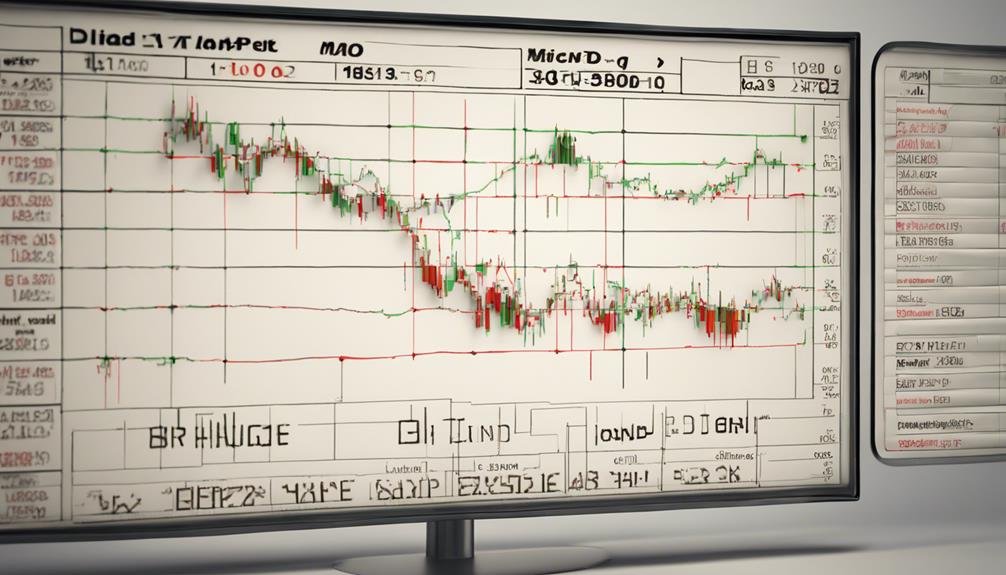Bid and Ask Definition, How Prices Are Determined, and Example
Bid and ask prices are crucial in trading, reflecting market demand and supply. The spread between them indicates liquidity levels and affects trading costs. Market dynamics determine prices through the interplay of supply and demand. Traders use strategies like limit orders to manage bid-ask spreads. Understanding these factors helps in making well-informed decisions. Market makers focus on maximizing profits by managing bid-ask spreads efficiently. Monitoring spreads aids in evaluating market conditions for successful trading. Explore how bid and ask prices influence market dynamics and price determination for a detailed view.
Key Takeaways
- Bid and ask prices determine the cost of securities trading.
- Market demand is reflected in bid prices, while supply is mirrored in ask prices.
- Price determination is influenced by the equilibrium of buying and selling pressures.
- Market makers manage bid-ask spreads for price stability and liquidity.
- Understanding supply and demand dynamics is critical for successful trading strategies.
Bid and Ask Definition
The bid and ask prices, fundamental to securities trading, represent the respective thresholds at which buyers and sellers engage in transactions. Market participants utilize these prices to execute their trading strategies.
Liquidity, a vital factor in market efficiency, is gauged by the spread between the bid and ask prices. Understanding these prices aids in price discovery, as bid prices reflect market demand, while ask prices mirror supply.
Efficient execution strategies involve buying at the ask price and selling at the bid price, influencing the bid-ask spread. Market dynamics and investor sentiment play a significant role in determining these prices, impacting trading costs.
Market makers, by benefiting from bid-ask spreads, contribute to price stability and market efficiency.
Understanding Bid-Ask Spread
Analyzing bid-ask spreads provides valuable insight into the cost efficiency of trading activities in financial markets. The bid-ask spread represents the difference between the highest price a buyer is willing to pay (bid) and the lowest price a seller is willing to accept (ask).
A narrow spread indicates high liquidity, benefiting traders with lower trading costs. Understanding bid-ask spreads is essential for implementing effective trading strategies and conducting liquidity analysis.
Traders often aim to minimize the impact of spreads on profits by strategically entering and exiting positions. Monitoring bid-ask spreads helps investors gauge market conditions and assess the implied costs of trading.
Bid-Ask Spread Impact
Understanding the impact of bid-ask spreads on trading costs and market dynamics provides valuable insights for investors and traders alike. The bid-ask spread directly affects the cost of executing trades, influencing the profitability of various trading strategies. Tighter spreads are favorable for traders as they reduce costs, making liquidity management more efficient.
Traders often employ strategies to navigate bid-ask spreads effectively, such as using limit orders to control execution prices. Additionally, understanding how bid and ask prices reflect supply and demand dynamics is essential for implementing successful trading strategies. By monitoring bid-ask spreads and market conditions, traders can make informed decisions to optimize their trading outcomes and manage liquidity effectively.
Market Dynamics and Price Determination
Market dynamics and price determination are intricately linked to the equilibrium between buying and selling pressures in financial markets. Price fluctuations are driven by the interplay of demand and supply. When demand surpasses supply, bid and ask prices rise, reflecting an increased interest in buying.
Conversely, when supply outweighs demand, bid and ask prices fall as sellers compete to attract buyers. Investor sentiment plays a vital role in shaping these dynamics, influencing the willingness to buy or sell at certain price levels. Market conditions, economic indicators, and news can all impact investor sentiment, thereby affecting the balance between supply and demand.
Understanding these factors is essential for investors seeking to navigate market dynamics and make informed decisions.
Market Makers and Bid-Ask Spread
The profitability of market makers hinges greatly on the bid-ask spread, serving as a key determinant of their financial gains within the market ecosystem. Market makers employ various strategies to manage spreads effectively, aiming to maximize profits while providing liquidity to the market. Spread analysis is vital for market makers to assess the market conditions and adjust their pricing strategies accordingly. Economic data releases and market news can have a notable impact on bid-ask spreads, requiring market makers to adapt swiftly to changing circumstances. By understanding market dynamics and utilizing advanced pricing models, market makers can navigate the fluctuations in bid-ask spreads efficiently.
| Market Maker Strategies | Spread Analysis | Profit Maximization |
|---|---|---|
| Providing Liquidity | Monitoring | Adjusting Pricing |
Conclusion
To summarize, bid and ask prices are like the gears of a well-oiled machine in the financial markets, working together to facilitate transactions and reflect market equilibrium. Understanding the intricacies of bid-ask spreads, market dynamics, and the role of market makers is essential for investors seeking to navigate the complexities of asset valuation.
By delving into these concepts and their real-world applications, investors can make informed decisions and navigate the ever-changing landscape of financial markets with confidence.







